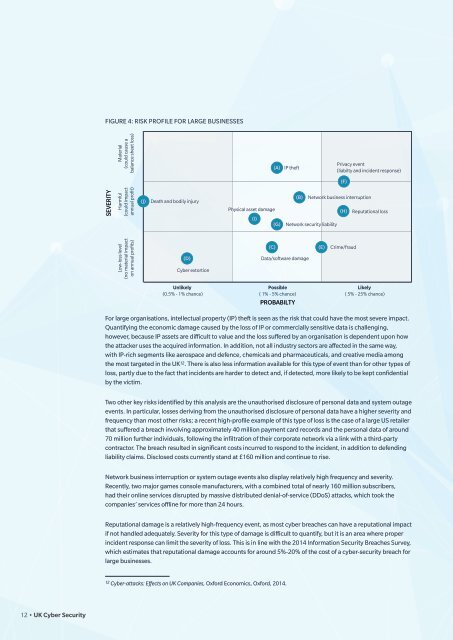k88nFi
k88nFi
k88nFi
Create successful ePaper yourself
Turn your PDF publications into a flip-book with our unique Google optimized e-Paper software.
FIGURE 4: RISK PROFILE FOR LARGE BUSINESSESMaterial(could cause abalance sheet loss)(A)IP theftPrivacy event(liabilty and incident response)(F)SEVERITYHarmful(could impactannual profit)(J)Death and bodily injuryPhysical asset damage(I)(G)(B) Network business interruption(H) Reputational lossNetwork security liabilityLow-loss level(no material impacton annual profits)(D)Cyber extortion(C)Data/software damage(E)Crime/fraudUnlikely(0.5% - 1% chance)Possible( 1% - 5% chance)PROBABILTYLikely( 5% - 25% chance)For large organisations, intellectual property (IP) theft is seen as the risk that could have the most severe impact.Quantifying the economic damage caused by the loss of IP or commercially sensitive data is challenging,however, because IP assets are difficult to value and the loss suffered by an organisation is dependent upon howthe attacker uses the acquired information. In addition, not all industry sectors are affected in the same way,with IP-rich segments like aerospace and defence, chemicals and pharmaceuticals, and creative media amongthe most targeted in the UK 12 . There is also less information available for this type of event than for other types ofloss, partly due to the fact that incidents are harder to detect and, if detected, more likely to be kept confidentialby the victim.Two other key risks identified by this analysis are the unauthorised disclosure of personal data and system outageevents. In particular, losses deriving from the unauthorised disclosure of personal data have a higher severity andfrequency than most other risks; a recent high-profile example of this type of loss is the case of a large US retailerthat suffered a breach involving approximately 40 million payment card records and the personal data of around70 million further individuals, following the infiltration of their corporate network via a link with a third-partycontractor. The breach resulted in significant costs incurred to respond to the incident, in addition to defendingliability claims. Disclosed costs currently stand at £160 million and continue to rise.Network business interruption or system outage events also display relatively high frequency and severity.Recently, two major games console manufacturers, with a combined total of nearly 160 million subscribers,had their online services disrupted by massive distributed denial-of-service (DDoS) attacks, which took thecompanies’ services offline for more than 24 hours.Reputational damage is a relatively high-frequency event, as most cyber breaches can have a reputational impactif not handled adequately. Severity for this type of damage is difficult to quantify, but it is an area where properincident response can limit the severity of loss. This is in line with the 2014 Information Security Breaches Survey,which estimates that reputational damage accounts for around 5%-20% of the cost of a cyber-security breach forlarge businesses.12 Cyber-attacks: Effects on UK Companies, Oxford Economics, Oxford, 2014.12 • UK Cyber Security


